The eight primal cuts of beef are round, loin, flank, rib, short plate, chuck, shank, and brisket.
As a seasoned pitmaster for 12 years running, I have handled more than my fair share of beef cuts. Primal cuts are the first to be separated from the steer’s carcass.
Each cut is comprised of several sub-primal cuts that share similar characteristics because they are cut from the same section. That said, each cut is unique and suited to a particular cooking method that may not work as well for a different cut.
This article is your informative guide to primal beef cuts, their sub-primal cuts, and their characteristics. You will also learn the best cooking methods for each of the cuts and what we mean by a primal cut. Let’s start from the tip to the top:
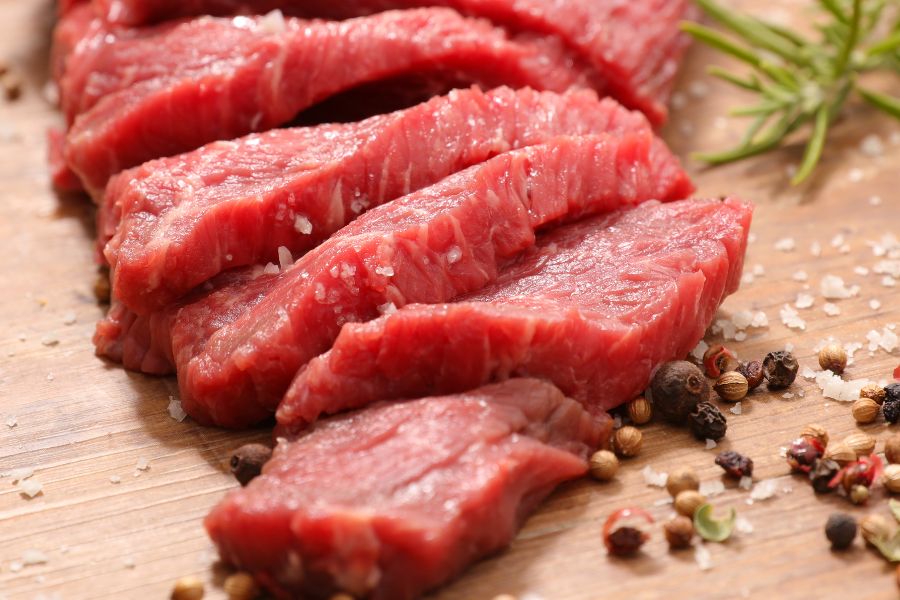
Here are the 8 primal cuts of beef explained:
The round primal cut is located near the steer’s hind legs. It is comprised of rump meat and is a lean cut with a low fat content.
The round sits between the tail and the loin and flank cuts.
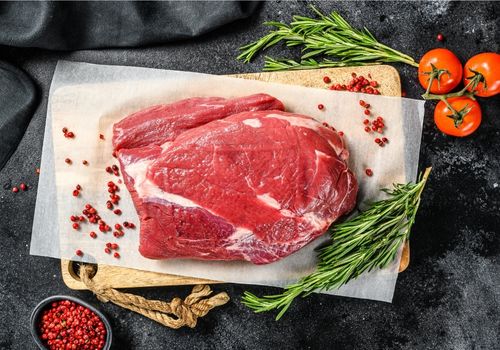
Secondary cuts from the round include the sirloin tip, bottom round, top round, heel of round, and eye of round.
Related Reading
What Are Chip Steaks: And How to Cook it Like a Pro
The hind legs support a lot of weight and get a lot of exercises when the steer is mobile. The round primal cut has a lot of cartilage, ligaments, tendons, and connective tissue which means it can be chewy and downright unpleasant if not cooked properly.
Subprimal cuts from the round are all lean cuts with low-fat content and are low-priced.
They are best-suited for slow cooking methods that allow enough time for the rich, connective tissue to be broken down.
These sub-primal cuts can also be chopped into thin pieces and dried out to make beef jerky.
Ground round meat can be mixed with a little extra fat like eggs, olive oil, or cheese and used in other dishes like stews and braising recipes.
The loin is located towards the lower back of the steer. It is sandwiched between the rib and round cuts. The loin sits above the flank cut and the short plate cut.
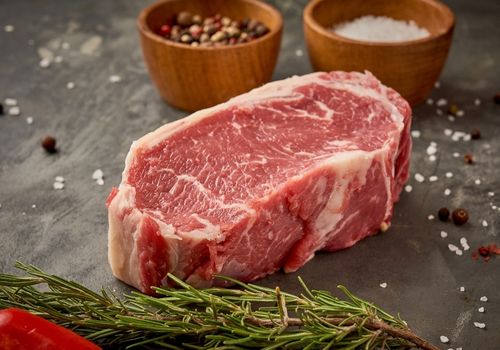
The loin is majorly divided into two, the sirloin and the short loin.
The sirloin and the short loin are both tender cuts of beef, however, the short loin is more tender because it is located closer to the center of the steer.
Cuts from the sirloin include sirloin steak, top sirloin, tri-tip roast, tri-tip steak, and bottom sirloin.
Short loin cuts include the New York strip, T-bone steak, porterhouse, tenderloin fillet, filet mignon, strip loin, and chateaubriand.
Related Reading
Sirloin cuts are typically best for grilling.
Short loin cuts are delicate, expensive cuts that are considered the crème-de-la-crème of beef cuts. They are best stir-fried and served rare or medium-rare.
The flank primal cut is a thin cut of beef located on the underbelly of a cow. It sits above the loin, right between the round and short plate cuts.
Since this is a well-exercised muscle, the meat in this region has a tight network of fibers that make the meat tough and dry.
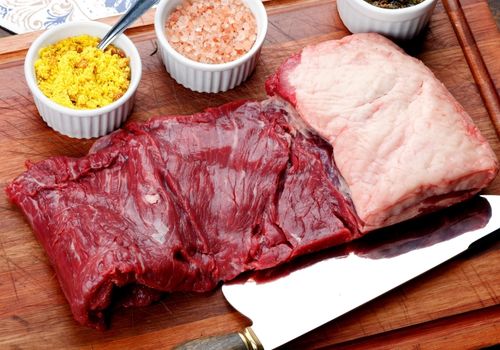
The subprimal cuts from the flank cut include the famous London broil and flank steak.
Extra meat from the flank steak is most often sold as lean ground beef.
The flank steak takes well to marinades that have a high acidic content. The acid serves to tenderize the meat. So, for best results, cut your flank steak into desired pieces and leave it marinated overnight in the fridge.
Cook your marinated flank steak using direct heat methods like grilling until medium-rare. Don’t cook flank steak more than is necessary since it tends to dry out when cooked for too long.
Flank steaks are great for fajitas, pizza toppings, and beef salads.
Related Reading
The rib cut of beef sits between the chuck and the loin, right above the short plate.
This primal cut comprises only the last 6 pairs of the cow’s ribs out of 13 pairs. The rest of the beef ribs are housed in the chuck and short plate cuts.
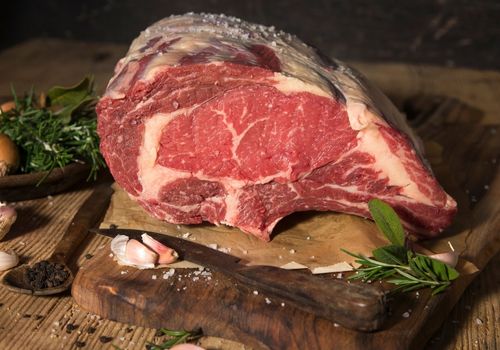
Rib cuts are known for their distinct, rich beefy flavor and their mouth-watering fat content. They are highly priced compared to other beef cuts.
Secondary cuts from the rib primal cut are the short ribs and back ribs. The rib steak, ribeye steak, and prime rib are renowned for their delicious prime rib roast.
In the United States, ribeye steak refers to a de-boned rib steak, even though the two terms are used interchangeably.
The prime rib is best-suited to high cooking temperatures for a short time. This will give you a crispy bark while keeping the center rare.
Carve it into portions to make it easier to cook to different levels of doneness. This way, you can satisfy different palettes.
Ribeye steaks require direct heat grilling. They are elevated by wood flavors, so feel free to toss in a few of your favorite wood chips. I use Trager Signature Blend since it has a nice mix of wood flavors.
Short ribs should be braised first to make them tender. You can rub them generously with BBQ sauce before grilling.
Back ribs are best for indirect heat cooking methods. Cook on low heat and allow sufficient cooking time to yield tender results.
The short plate cut is located towards the lower abdomen of a steer. It sits between the shank and flank cuts right below the rib.
Short plate ribs are also called ‘brisket on a stick’.
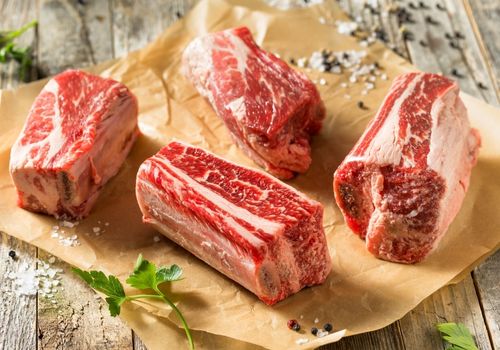
Subprimal cuts from the short plate include the skirt steak, hanger steak, and short plate ribs. These cuts tend to be tough and fatty.
The hanger steak is a coveted cut that’s usually seasoned and grilled till medium-rare.
The skirt steak is tougher than the hanger and is best marinated preferably overnight before being grilled over direct heat.
If you like strong flavors, take it out of the marinade and generously rub it with your favorite BBQ sauce. I like Killer Hogs BBQ Rub since it goes well with steaks.
The skirt steak is the preferred meat to make fajitas but it also finds its way onto sandwiches and pizzas.
Short plate ribs are perfect either grilled or smoked because they have a rich marbling that renders as it flavors the ribs.
Extra meat from the short plate is usually made into ground beef for recipes like kebabs, meatballs, and hamburgers.
Related Reading
The chuck consists of the upper shoulder and lower neck of a steer. It sits above the shank and brisket cuts, between the rib cut and the head of the steer.
It’s also known as the 7-bone steak because of its appearance.
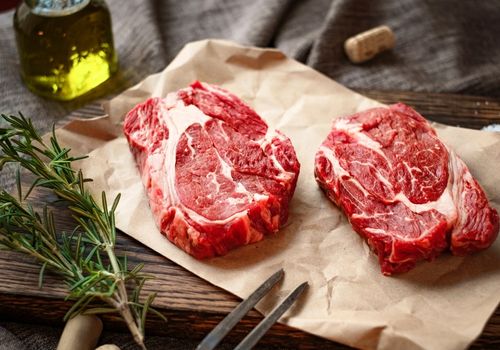
Subprimal cuts from the chuck primal include the neck, shoulders, top and bottom blades, beef chuck steak, and chuck filet.
Popular retail cuts from the chuck include the flat iron steak, Denver steak, chuck short ribs, the 7-bone roast, and ground beef perfect for hamburgers.
Sub-primal cuts from the chuck have bold beef flavors elevated by their high-fat content. However, when cooked wrong, they can end up with a bland, chewy taste.
The shoulder and neck cuts are best cooked using moist methods like braising or stewing in a slow cooker.
Beef ribs yield tender, flavorful results when cooked, using indirect heat methods for a long time. Such methods include smoking, roasting, and grilling. Don’t forget to use a dry or wet rub to boost the flavor. If you have time, let the meat sit in a marinade overnight.
The blade and flat iron steaks have a rich marbling and are best seasoned and grilled over direct heat.
The chuck steak and chuck filet are normally tenderized and pounded with a mullet to flatten them out. They are used in recipes like chicken fried steaks and beef roulade.
The shank primal cut is located in the chest region on the cow around the forearm. It sits between the brisket and short plate cuts. Since this muscle gets a lot of exercises, it is a tough and dry cut.
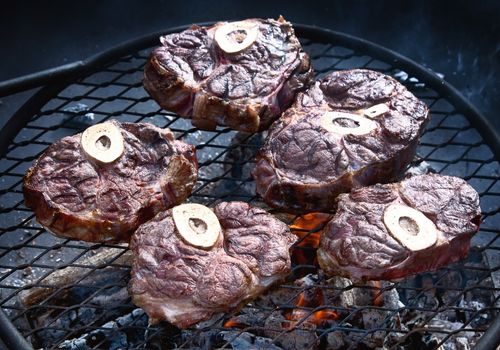
Subprimal cuts from the shank include the fore shank, hind shank, and ground beef.
Since the shank is a dry, tough cut, it’s best cooked using moist heat methods for extended periods. This will allow the muscle fibers to be broken down by the heat and the liquid absorbed into the meat to make it succulent and toothsome.
It’s no wonder that the shank is a popular cut in beef soups, beef stews, and beef stocks as well as in other dishes like Osso Bucco, which have a high water content.
Extra meat from this cut is usually made into ground beef. Ground beef is mixed with fat from eggs or cooking oil for recipes that require minced beef like kebabs, meatballs, and pizza toppings.
The brisket also called a whole packer, is located between the forelegs of the steer. It sits under the chuck in front of the shank.
It is a large common cut and is the preferred choice for corned beef, pot roast, and pastrami.
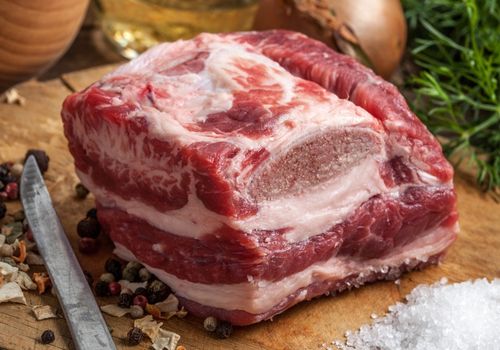
The brisket is usually divided into two, the flat and the point.
The flat is the larger of the two cuts. It’s very rich in connective tissue and is also called the first cut.
The point, also known as the second cut, is the smaller piece and is directly attached to the rib cage. It has dense meat and a big fat cap.
Both the point and the flat are lean and can be very tough if not cooked properly.
The brisket is best cooked under indirect heat. Cook it low and slow to break down the connective tissue. For flavorful results, marinade or brine your brisket overnight before cooking it.
Related Reading
A primal cut refers to the first pieces to be separated from the carcass during the butchering process. A steer has 8 primal cuts, while a pig has 4 primal cuts.
Primal cuts are easy to confuse with prime cuts due to similar wordage but the latter simply refers to the best cuts of beef that are highly-priced like the T-bone steak, ribeye steak, prime rib, filet mignon, sirloin tip, and tenderloin, among others.
Each primary cut is further divided into multiple subprimal cuts. Subprimal cuts are then divided into primals.
The characteristics of primals and their suitable cooking methods largely depend on the primal cut they are derived from.
The butchering process is pretty standard in most parts of the United States, where the beef carcass is primarily cut into 8 pieces. However, the number of cuts can differ across different cultures and countries.
Some butchers have 9 primal cuts since they regard the short loin and the sirloin to be two separate primal cuts.
All cuts of beef have the potential to yield tender results but only when subjected to the appropriate cooking process. This starts with understanding their unique characteristics.